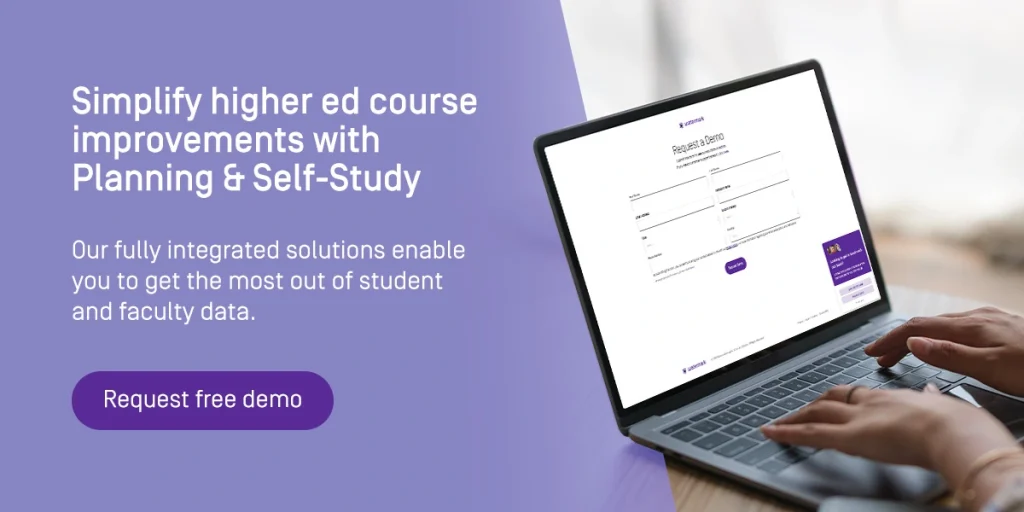




Higher education is a big investment for students and their families. They need to know their money is being well-spent when they choose an institution, which is why the course review process is so important. Implementing a culture of continuous improvement regarding course quality is critical for ensuring your institution provides the best value possible.
Using the right tools can make this process much smoother. Watermark Planning & Self-Study is an industry-leading software solution that helps the entire institution analyze and improve its course offerings year after year to better serve its students. Let’s explore how.
When strategizing how to plan course improvements most effectively, it all comes back to your data. Having access to enough high-quality information gives you the insight you need to make sound decisions in every area of your institution.
Some examples of the data you might use to identify course improvements include:
Whether they transfer to another course early in the semester or drop the class before the final, students are more likely to leave courses they don’t see the value in completing. Analyzing completion data can help you identify the courses that need the most work — or that you should drop from your catalog entirely.
Course evaluation surveys and student satisfaction polls are excellent sources of information about course quality and instructor performance. Anonymous online surveys give students a space to explain their thoughts on the course materials, the professor’s teaching style, the subject matter, or anything else that affected their learning experience.
Of course, you need to make it easy for students to complete these evaluations in order to collect the most comprehensive data possible. Integrated software solutions allow students to fill out the evaluation using the tools they’re already familiar with, so instructors can simply add it to their course materials and open it for responses at the end of the semester.
If students aren’t engaged with the materials they’re learning, they’re less likely to see the course through to completion. Look for courses that have abnormally low engagement levels, or where engagement drops off after a certain period of time.
Student feedback from course evaluation surveys can be invaluable in determining the root causes of the issue. Maybe the course uses an outdated textbook, or maybe the instructor should give students more opportunities for independent learning. Whatever the cause, your course data is critical for formulating the best plan for improvement.
Students often disengage when they can’t clearly see how a course connects to any expected learning outcome. Conducting a curriculum gap analysis can help you determine whether a specific course aligns with the program’s overarching knowledge and skills goals.
Open datasets on student outcomes, including labor market data, are also invaluable for understanding how your curriculum connects to student success post-graduation. Does each course in the program adequately develop the necessary skills for entering the workforce? How long does it take before students gain employment in their chosen fields?
Sometimes the biggest contributing factor to a course’s quality isn’t the course materials or the content — it’s the person leading the class. A great professor will motivate and inspire their students to do their best work, keeping them engaged even if the course itself is challenging.

Many institutions include faculty assessments in their course evaluations, which helps streamline the process for students and administrators alike. Accessible survey tools that integrate with your other software gives students a streamlined, user-friendly place to critique the impact their instructor had on the course. And intelligent automated features eliminate the need to manually copy survey data between systems, saving valuable time and reducing human error.
Data silos are the norm at most higher ed institutions, where every faculty member uses a different system to store and organize their data. No one else has access when faculty members are out or otherwise unavailable. Without a standardized system for formatting that data, migrating it to most legacy systems is an unnecessarily complex process.
Integrated data analytics software consolidates all your course data — including student feedback, assessment results, engagement, and more — to create a single source of truth for your entire institution. You can eliminate data silos and gain complete visibility into every area of your institution, including course data, and generate insights that drive real improvement.
Adding new tools to your institution’s tech stack can be a challenge if not planned out properly. Here are some best practices that can help you ensure you’re on the right track:
If your institution needs an accreditation readiness solution, our comprehensive software suite can help you. Watermark Planning & Self-Study is our solution for simplified assessment planning and program review. The intuitive, user-friendly interface automates repetitive data entry and migration tasks so administrators can focus on more valuable operations.
Streamline the self-study process with customizable report templates and advanced analytics at every level of your institution. Interactive dashboards unlock the narratives behind your data so everyone on your team has full visibility into the subject of assessment.
Plus, turnkey integrations with all Watermark products and other leading campus software systems improve data quality and eliminate redundancy, enabling greater productivity and standardization in all accreditation readiness tasks.
At Watermark, we strive to help higher education institutions provide the most value to their students. Our fully integrated solutions enable you to get the most out of student and faculty data so you can identify key areas for growth and improvement.
And we’re expanding. We recently partnered with Lightcast — the leader in labor market data analytics — to create the Market Landscape Data Pack. Close the program review narrative loop with insights from the most up-to-date job market data available, including average earnings, degree completions, workforce demographics, and more.
Request your free demo today to see our software in action.






























































































































































































































































































































































































